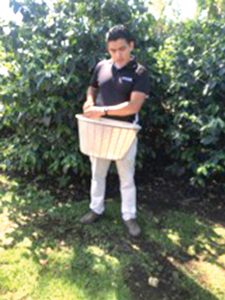Learning more about growing coffee
Published 12:00 am Friday, June 7, 2019
By Mackenzie Hall
Rowan County Cooperative Extension Intern
Before starting my internship with Rowan County Extension this summer, I was able to go to Costa Rica with my university. I am a senior at the University of Mount Olive studying agriculture production systems with a concentration in animal science, so anywhere I go I am always drawn to see what agriculture practices are around me.
While in Costa Rica I became fascinated with their agriculture. Before this trip I was unaware of the diversity and the amount of amazing products they grew.
Like me, many may not realize that agriculture is a large source of income to Costa Rica, although their commodities are a bit different than what we raise in North Carolina. It is a very tropical area due to its location being 10 degrees north of the equator.

Submitted photo A worker is demonstrating how he gets ready to harvest and how he harvest the beans.
Their agriculture products consist of pineapples, sugar, other tropical fruits such as mango and papaya, ornamental plants, corn, potatoes and palm oil, rice and, without a doubt, bananas and coffee being the largest exports. Costa Rica is one of the largest exporters in the world for bananas.
In my previous trip to Costa Rica, we drove past was seemed like hundreds of banana fields that went on for miles. We even got to pick a banana right off the tree and eat it. It was the best banana I have ever had.
Another large staple in Costa Rica is coffee. About 90% of Costa Rican coffee is designed for export and only 10% for in-country consumption. We were able to tour one of the largest coffee plantations, Doka Coffee Estates. If you ever get to try their coffee, I highly recommend it. Doka Coffee has remained a top producer as it’s been passed down from generations. It is the oldest “wet mill” in the country.
Let’s take a further look into what it takes for us to get fresh brew in the mornings. The first step is planting the coffee trees and watching it grow. This is the slow part. Trees will not start producing beans until the third or fourth year of life, but after they start, one tree alone will produce beans for roughly 20 years. The ripening and picking of the beans starts in October and ends around April.
Since the beans on a tree do not ripen at the same time, each tree must be re-checked every two weeks. A typical work day for the bean pickers is 6 a.m. to 4 p.m. since it gets dark around 5 p.m. Workers are paid on how many pound/baskets they pick. One basket is equivalent to 27 pounds and one basket equals $2 pay.
On our tour, we spoke with an experienced picker who said it typically takes him an hour to an hour and a half to pick one basket. After a truckload has been harvested it is taken to the first step. The coffee is measured, marked and then dumped into a large vat of water. This separates the good quality beans from the lower quality, based on their weight.
The ripe beans go to the bottom and then are sent to the peeling process. After they are peeled, they go into the fermenting tanks. Once they are finished in the fermenting tanks, they are sent to be dried. The lower quality beans are mechanically dried but the higher quality ones are laid on flat concrete areas that look like parking lots. These beans will be flipped every 45 minutes for 48 hours between 6 a.m. and 4 p.m.
After they have been properly dried, they are moved to the roasting station. To get the different flavors and caffeine levels in the coffee, they have to be roasted different amounts of time. A light roast is only 15 minutes, a medium roast, 17 minutes, and a dark roast takes 20 minutes.
Different types of roast are mixed with each other to get different blends, such as their breakfast and house blends. The beans that do not meet the high-quality standards are shipped to companies such as Costco, Greenhouse and gas stations for their production purposes.
After this trip, I found an even greater love and appreciation for where my coffee comes from. I did return home with a carry on full of coffee to share with my friends and family.



